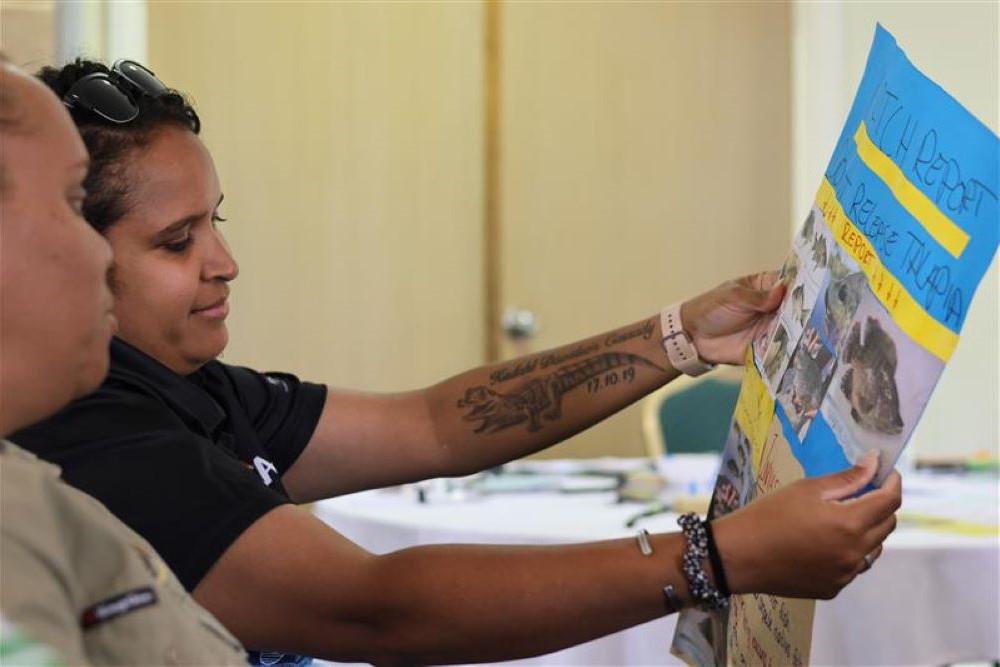Torres Strait Island Regional Council
The Torres Strait Island Regional Council (TSIRC) represents 15 island communities across more than 42,000 square kilometres of sea and land. The Torres Strait shares an international border with Papua New Guinea.
As the largest Indigenous council in Australia, it combines cultural authority with operational leadership to safeguard one of the country’s highest biosecurity risk regions.
Biosecurity in the Torres Strait is about more than science. It is about Caring for Country and community. TSIRC’s work is grounded in Torres Strait Islander knowledge and guided by Elders and Traditional Owners. Programs consider seasonal signs, sacred sites and totemic species. Education is delivered in local language and through traditional teaching methods, ensuring communities feel ownership and can pass knowledge on.
The council leads locally driven programs that manage pests, weeds, animal health and invasive species across the region. This includes surveillance, education, emergency planning and hands-on response work. By aligning cultural knowledge with government partnerships, the council protects local livelihoods and national interests.
For example, the Exotic Fruit Fly Block Program, delivered in partnership with Biosecurity Queensland, monitors for pests like Bactrocera dorsalis. Community knowledge is used to decide where traps should go and when to monitor them. This helps protect Australia’s fruit-fly exclusion zones, which are critical to national trade.
Another key program is animal biosecurity. Working with Animal Management in Rural and Remote Indigenous Communities (AMRRIC) and Queensland Health, the council supports desexing, pet ownership education and disease monitoring. This reduces the risks of rabies, ehrlichiosis and other serious conditions reaching the mainland. A pilot project trialled a ‘no survey without service’ model, where staff provided clinical care while conducting surveillance. This built trust, improved disease detection and created stronger local capacity.
The council also delivers invasive species programs under the Torres Strait Regional Biosecurity Plan. High-risk threats such as Salvinia molesta, Mimosa pigra, feral pigs, cane toads and tramp ants are managed through island-specific responses. These efforts are in close collaboration with prescribed body corporates and community groups, ensuring that cultural authority and community priorities guide the work.
Education is another pillar of the council’s approach. Co-designed with AMRRIC and Environmental Health Workers, education programs raise awareness in schools and communities about everyday biosecurity practices. Virtual delivery reduces travel costs, improves accessibility across remote islands and builds workforce capability.
The Environmental Health Worker team is at the heart of the council’s work. All team members are Indigenous and locally employed within their 15 island communities. Many hold or are completing formal qualifications in Indigenous environmental health, adding professional recognition to cultural knowledge. Their work encompasses barge inspections, pest and weed control, animal management, waste management and biosecurity surveillance.
Through this work, TSIRC shows how First Nations-led leadership can address challenges of national significance. By protecting traditional food systems, public health and the natural environment, the council also protects Australia’s northern biosecurity frontier.
TSIRC demonstrates cultural strength, operational excellence and deep community ties. Its leadership proves that biosecurity is strongest when built on local wisdom, cultural accountability and community ownership.
Watch a video about their work
Introduction
This is the accessible text transcript of the 2025 Australian Biosecurity Awards winner video featuring Dawson Sailor.
Transcript
[Kalaw Kawaw Ya] Kapu Goeyga (Good day)
[Meriam Mir] Debe Gerger Wabim (Good day everyone)
On behalf of the Torres Strait Island Regional Council, I am proud to accept this award in the First Nations category.
This recognition belongs to all the Elders in the 15 communities and all Indigenous Environmental Health Workers.
We work strongly every day to protect Country, culture and people.
The Torres Strait is a unique and sensitive region, and our approach is simple but powerful.
We combine cultural knowledge with scientific methods to deliver programs in partnership with our communities, from exotic fruit fly surveillance and invasive weed control to companion animal health and biosecurity education.
Our Environmental Health Workers, all Indigenous, all locally based, are the ones on the frontline of biosecurity in every island community.
Their leadership, their vigilance and their cultural authority make our programs trusted and effective and keep our islands and all Australia safe from biosecurity threats.
We also recognise the vital role of the Biosecurity Working Group in our region and gratefully acknowledge the support of our key stakeholders, including Department of Agriculture, Fisheries and Forestry, Biosecurity Queensland and Queensland Health.
We look forward to strengthening these collaborative partnerships into the future.
We accept this award with pride, but also with the responsibility to continue building capacity for our people, to strengthen the role of Indigenous knowledge in national biosecurity, and to ensure that the Torres Strait remains a safe, healthy and resilient region for generations to come.
It’s time we walk together, community and government, for build a strong future for our pikinini (children).
Photos




